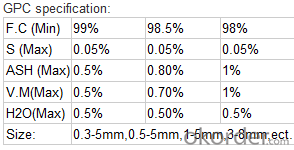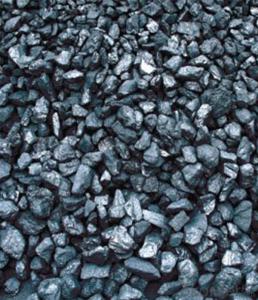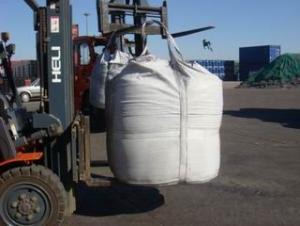FC 93 percent Carbon Additive Supplied By CNBM China
- Loading Port:
- China main port
- Payment Terms:
- TT or LC
- Min Order Qty:
- 30 m.t.
- Supply Capability:
- 1000 m.t./month
OKorder Service Pledge
OKorder Financial Service
You Might Also Like
Specifications
Calcined Anthracite
Fixed carbon: 90%-95%
S: 0.5% max
Size: 0-3. 3-5.3-15 or as request


Calcined petroleum coke is formed from the by-product of crude oil distillation. Available in wide ranges of types and morphologies to meet the application,
these materials have a dark, flat sheen. They are high in carbon but have reduced lubrication, electrical
and thermal conductivity properties, and are mainly used as a filler.
PARAMETER UNIT GUARANTEE VALUE | |||||
F.C.% | 95MIN | 94MIN | 93MIN | 92MIN | 90MIN |
ASH % | 4MAX | 5MAX | 6MAX | 7MAX | 8MAX |
V.M.% | 1 MAX | 1MAX | 1.5MAX | 1.5MAX | 1.5MAX |
SULFUR % | 0.5MAX | 0.5MAX | 0.5MAX | 0.5MAX | 0.5MAX |
MOISTURE % | 0.5MAX | 0.5MAX | 0.5MAX | 0.5MAX | 0.5MAX |
Size can be adjusted based on buyer's request.
Pictures of Calcined Anthracite:


We can supply below furnace charges, please feel free to contact us if you areinterested in any of any of them:
Coke (Metallurgical, foundry, gas)
Calcined Anthracite with fixed carbon from 90% to 95%
Our Service:
1. Your inquiry related to our products or prices will be replied in 24hours.
2. Manufacturer with large capacity, ensure the fast production cycle after confirmed the order.
3. Our professional technicians will answer your entire enquiry in patient.
4. To meet the refractory solutions, we can serve as your instructions.
5. Protection of sales area and private information for our entire customer.
- Q:What are the effects of carbon emissions on the stability of grasslands?
- Grasslands are significantly impacted by carbon emissions, which have various negative effects. One major consequence is the modification of the climate, particularly through the greenhouse effect. Carbon dioxide (CO2) is a primary greenhouse gas, and the higher concentration of CO2 in the atmosphere leads to global warming. This rise in temperature disrupts the natural growth patterns of grasslands and disturbs the delicate balance of their ecosystems. The increased temperatures caused by carbon emissions can result in higher rates of evaporation, leading to drier soil conditions. Grasslands are adapted to specific levels of moisture, and any alterations in these conditions can reduce plant growth and increase vulnerability to drought. Consequently, grasslands become less stable and more susceptible to desertification. Furthermore, elevated levels of carbon dioxide can impact the nutritional quality of grasses. As CO2 concentrations rise, the relative proportion of essential nutrients in grasses may decrease. This phenomenon, called nutrient dilution, can affect the health and productivity of herbivores that depend on these grasslands for sustenance. The decline in nutritional value disrupts the delicate balance of predator-prey relationships and contributes to a decrease in biodiversity. In addition, carbon emissions contribute to soil acidification. Increased carbon dioxide dissolves in rainwater, forming carbonic acid, which lowers the pH of the soil. Grasses are sensitive to changes in soil pH, and acidification negatively affects their growth and nutrient absorption. Acidic soil conditions can also lead to the loss of crucial microorganisms that contribute to a healthy soil ecosystem, further destabilizing grasslands. Lastly, carbon emissions indirectly affect grasslands through climate change-induced changes in precipitation patterns. Shifts in rainfall patterns can alter the composition and distribution of plants, favoring invasive species or disrupting the competitive balance between different grass species. This disturbance can compromise the stability and functioning of grassland ecosystems. In conclusion, carbon emissions have multiple detrimental effects on the stability of grasslands, including climate changes, increased susceptibility to drought, nutrient dilution, soil acidification, and alterations in precipitation patterns. It is essential to reduce carbon emissions and mitigate the impacts of climate change to preserve the stability and integrity of grassland ecosystems.
- Q:What are the consequences of increased carbon emissions on vulnerable communities?
- Increased carbon emissions have severe consequences on vulnerable communities. These communities, often located in low-income areas or developing countries, bear the brunt of climate change impacts such as extreme weather events, rising sea levels, and reduced access to resources like clean water and food. These consequences exacerbate existing social and economic inequalities, leading to displacement, loss of livelihoods, increased health risks, and even conflicts over scarce resources. It is crucial to address carbon emissions and support these communities to build resilience and adapt to the changing climate.
- Q:How is carbon used in the production of adhesives?
- Carbon is used in the production of adhesives in several ways. One common method involves the use of carbon black, which is a fine powder made from the incomplete combustion of hydrocarbon fuels. Carbon black is added to adhesives to improve their strength, durability, and resistance to UV radiation. It acts as a reinforcing agent, increasing the adhesion and cohesion properties of the adhesive. Additionally, carbon fibers are sometimes incorporated into adhesives to further enhance their strength and mechanical properties. These fibers are made by heating and stretching synthetic fibers or natural materials like rayon or petroleum pitch. When added to adhesives, carbon fibers provide increased tensile strength and stiffness, making them ideal for applications that require high-performance adhesives. Moreover, carbon-based polymers, such as epoxies and polyesters, are widely used in adhesive formulations. These polymers are created through chemical reactions involving carbon-based monomers. They offer excellent bonding properties, high resistance to heat and chemicals, and can be tailored to specific application requirements. Furthermore, carbon-based resins can be modified with other additives and fillers to achieve specific characteristics, such as flexibility, impact resistance, or flame retardancy. In summary, carbon is utilized in the production of adhesives through the incorporation of carbon black, carbon fibers, and carbon-based polymers. These materials significantly enhance the strength, durability, and other properties of adhesives, making them suitable for a wide range of applications in industries such as automotive, construction, electronics, and aerospace.
- Q:How is carbon dating used to determine the age of fossils?
- Carbon dating is a scientific method used to determine the age of fossils and other organic materials. It relies on the fact that carbon-14, an isotope of carbon, is present in the atmosphere and taken up by living organisms while they are alive. Once an organism dies, it no longer takes in carbon-14 and the amount of this isotope begins to decrease over time as it undergoes radioactive decay. To determine the age of a fossil using carbon dating, scientists first extract a small sample of the fossil. This sample is then treated with chemicals to remove any contaminants and extract the carbon from the organic material. The extracted carbon is then converted into carbon dioxide gas, which is used to create graphite targets for measuring the levels of carbon-14. Scientists use a technique called Accelerator Mass Spectrometry (AMS) to count the number of carbon-14 and carbon-12 atoms in the sample. The ratio of carbon-14 to carbon-12 is then used to calculate the age of the fossil, based on the known half-life of carbon-14, which is approximately 5730 years. By comparing the amount of carbon-14 remaining in the fossil to the amount of carbon-14 in the atmosphere at the time the organism died, scientists can determine the approximate age of the fossil. This method is particularly useful for dating organic materials up to about 50,000 years old. For older fossils, other methods such as potassium-argon dating or uranium-lead dating are typically used.
- Q:What are the advantages of carbon-based batteries?
- The advantages of carbon-based batteries include their relatively low cost, abundance of raw materials, and environmentally-friendly nature compared to other types of batteries. Additionally, they have a high energy density, allowing for longer battery life and greater power output.
- Q:What is the role of carbon 60 in industry? Can it be interchanged with the chemical properties of carbon? What is the chemical structure of carbon 60?
- Used to strengthen metals; used as a new catalyst for storage of gases
- Q:What is carbon offsetting in the energy sector?
- The energy sector engages in carbon offsetting by compensating for the greenhouse gas emissions generated from energy generation and consumption activities. This practice involves investing in projects that reduce or eliminate carbon dioxide (CO2) and other greenhouse gas emissions from the atmosphere. The main objective is to achieve a balance between the emissions released and the emissions reduced. Greenhouse gas emissions from the energy sector, particularly from the burning of fossil fuels like coal, oil, and natural gas, contribute significantly to global emissions. Carbon offsetting in this sector aims to mitigate the environmental impact of these emissions by financing projects that promote renewable energy, energy efficiency, and other measures to reduce carbon. There are various types of projects that can be supported through carbon offsetting in the energy sector. For instance, investments can be made in renewable energy projects such as wind farms, solar power plants, or hydropower facilities. These projects generate clean energy without emitting greenhouse gases and help replace fossil fuel-based energy sources, thus reducing overall emissions. Moreover, carbon offsetting can also support energy efficiency projects. These initiatives focus on reducing energy consumption by implementing energy-efficient technologies, improving insulation, or optimizing industrial processes. By reducing energy demand, these projects indirectly contribute to lower greenhouse gas emissions. Additionally, carbon offsetting in the energy sector can involve supporting initiatives that remove carbon dioxide from the atmosphere. These projects often include reforestation or afforestation efforts, which involve planting trees or restoring degraded forests. Trees absorb and store carbon dioxide through photosynthesis, thus offsetting emissions and combating climate change. In summary, carbon offsetting in the energy sector is crucial for transitioning towards a sustainable and low-carbon future. By investing in projects that reduce or eliminate greenhouse gas emissions, individuals, organizations, and governments can take responsibility for their carbon footprint and contribute to global efforts in addressing climate change.
- Q:What are the 3K, 12K, UD, etc. in the appearance requirements of the carbon fiber bicycle? What's the difference?
- 3K has 220 grams and 240 grams a square meter, we do carbon fiber automotive supplies, that is, the higher the number of 3K K, the width of each bundle of carbon fiber filaments, each bundle has hundreds of silk composition
- Q:How does carbon affect the fertility of soil?
- Soil fertility relies on carbon, which has a significant impact on various soil properties and processes. The addition of carbon to the soil improves its structure and ability to hold water. Organic matter, abundant in carbon, serves as a food source for microorganisms. These microorganisms play a crucial role in nutrient cycling and soil aggregation as they break down organic matter into simpler compounds. This process releases essential nutrients that plants can readily access. Furthermore, carbon acts as a sponge, preventing the leaching of nutrients like nitrogen and thereby increasing their availability for plants. Additionally, soils rich in carbon have higher cation exchange capacity, enabling them to retain and release nutrients more efficiently. By maintaining and increasing soil carbon levels, we can enhance soil fertility, facilitate plant growth, and support sustainable agricultural practices.
- Q:In Japanese, what's the difference between adding "carbon" and "sauce" after the name?
- Because this is similar to children's pronunciation is very cute, so sometimes good relationship between young people will use "carbon" pronunciation to install cute. So God, many animation or dramas in long sometimes "XX carbon ~" said.
1. Manufacturer Overview |
|
|---|---|
| Location | |
| Year Established | |
| Annual Output Value | |
| Main Markets | |
| Company Certifications | |
2. Manufacturer Certificates |
|
|---|---|
| a) Certification Name | |
| Range | |
| Reference | |
| Validity Period | |
3. Manufacturer Capability |
|
|---|---|
| a)Trade Capacity | |
| Nearest Port | |
| Export Percentage | |
| No.of Employees in Trade Department | |
| Language Spoken: | |
| b)Factory Information | |
| Factory Size: | |
| No. of Production Lines | |
| Contract Manufacturing | |
| Product Price Range | |
Send your message to us
FC 93 percent Carbon Additive Supplied By CNBM China
- Loading Port:
- China main port
- Payment Terms:
- TT or LC
- Min Order Qty:
- 30 m.t.
- Supply Capability:
- 1000 m.t./month
OKorder Service Pledge
OKorder Financial Service
Similar products
New products
Hot products





























